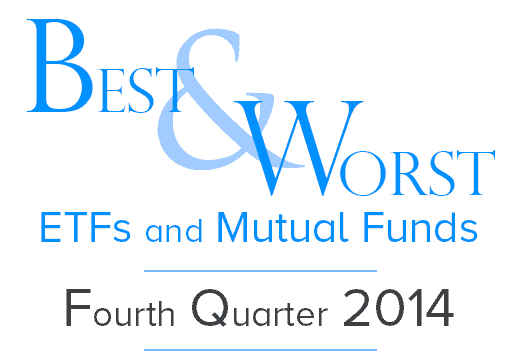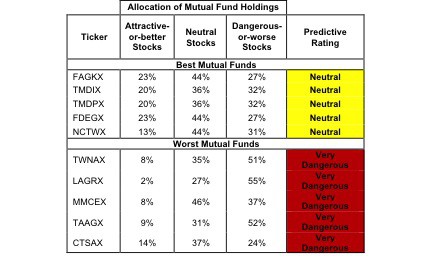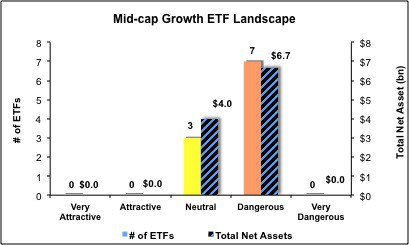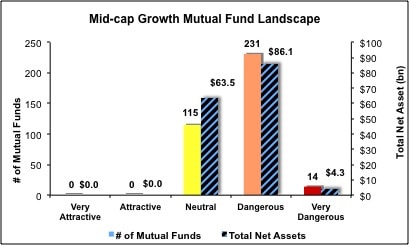The Mid Cap Growth style ranks eighth out of the twelve fund styles as detailed in my Style Rankings for ETFs and Mutual Funds report. It gets my Neutral rating, which is based on aggregation of ratings of 10 ETFs and 360 mutual funds in the Mid Cap Growth style as of July 16, 2013. Prior reports on the best & worst ETFs and mutual funds in every sector and style are here.
Figure 1 ranks from best to worst the eight Mid Cap Growth ETFs that meet our liquidity standards and Figure 2 shows the five best and worst-rated Mid Cap Growth mutual funds. Not all Mid Cap Growth style ETFs and mutual funds are created the equal. The number of holdings varies widely (from 19 to 541), which creates drastically different investment implications and ratings. The best ETFs and mutual funds allocate more value to Attractive-or-better-rated stocks than the worst, which allocate too much value to Neutral-or-worse-rated stocks.
To identify the best and avoid the worst ETFs and mutual funds within the Mid Cap Growth style, investors need a predictive rating based on (1) stocks ratings of the holdings and (2) the all-in expenses of each ETF and mutual fund. Investors need not rely on backward-looking ratings. My fund rating methodology is detailed here.
Investors should not buy any Mid Cap Growth ETFs or mutual funds because none get an Attractive-or-better rating. If you must have exposure to this style, you should buy a basket of Attractive-or-better rated stocks and avoid paying undeserved fund fees. Active management has a long history of not paying off.
Get my ratings on all ETFs and mutual funds in this style on my free mutual fund and ETF screener.
Figure 1: ETFs with the Best & Worst Ratings – Top 5
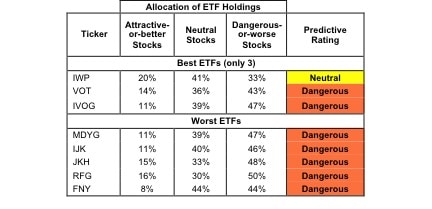 * Best ETFs exclude ETFs with TNAs less than $100 million for inadequate liquidity.
* Best ETFs exclude ETFs with TNAs less than $100 million for inadequate liquidity.
Sources: New Constructs, LLC and company filings
PowerShares RAFI Fundamental Pure Mid Growth Portfolio (PXMG) and ProShares Ultra Russell MidCap Growth (UKW) is excluded from Figure 1 because their total net assets (TNA) are below $100 million and do not meet our liquidity standards.
Figure 2: Mutual Funds with the Best & Worst Ratings – Top 5
Sources: New Constructs, LLC and company filings
Four mutual funds are excluded from Figure 2 because thair total net assets (TNA) are below $100 million and do not meet our liquidity standards.
iShares Russell Mid Cap Growth ETF (IWP) is my top-rated Mid Cap Growth ETF and Fidelity Growth Strategies Fund (FAGKX) is my top-rated Mid Cap Growth mutual fund. Both earn my Neutral rating.
First Trust Mid Cap Growth AlphaDEX Fund (FNY) is my worst-rated Mid Cap Growth ETF and Starboard Investment Trust Caritas All Cap Growth Fund (CTSAX) is my worst-rated Mid Cap Growth mutual fund. FNY gets my Dangerous rating, while CTSAX gets my Very Dangerous rating.
Figure 3 shows that 212 out of the 1389 stocks (over 14% of the market value) in Mid Cap Growth ETFs and mutual funds get an Attractive-or-better rating. However, zero out of 10 Mid Cap Growth ETFs and zero out of 360 Mid Cap Growth mutual funds get an Attractive-or-better rating.
The takeaways are: mutual fund managers allocate too much capital to low-quality stocks and Mid Cap Growth ETFs hold poor quality stocks.
Figure 3: Mid Cap Growth Style Landscape For ETFs, Mutual Funds & Stocks
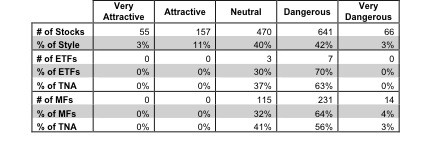
As detailed in “Low-Cost Funds Dupe Investors”, the fund industry offers many cheap funds but very few funds with high-quality stocks, or with what I call good portfolio management.
Investors need to tread carefully when considering Mid Cap Growth ETFs and mutual funds, as zero ETFs and zero mutual funds carry enough quality stocks to earn an Attractive rating. Investors would be better off focusing on individual stocks instead.
RenaissanceRe Holdings (RNR) is one of my favorite stocks held by Mid Cap Growth ETFs and mutual funds and earns my Very Attractive rating. RNR has grown profits (NOPAT) by 20% compounded annually since 1998. Moreover, RNR has a return on invested capital (ROIC) of 16%, putting it in the top quintile of all companies I cover. With a stock price of ~$88/share, RNR is also a steal for value investors. This price gives RenaissanceRe a price to economic book value ratio of 0.4, which means that the market expects the company’s profits to permanently decline by 60%. These expectations seem unlikely when looking at RNR’s history of growth, and investors would be wise to give RNR a serious look before its stock price starts to reflect its profits more accurately.
Cree Inc. (CREE) is one of my least favorite stocks held by Mid Cap Growth ETFs and mutual funds and earns my Very Dangerous rating. CREE’s profits (NOPAT) have declined by 6% compounded annually since 2005. CREE’s return on invested capital (ROIC) is 2%, which puts it in the bottom quintile of all companies I cover. Despite this history of underperformance, CREEs’ valuation implies the awfully high future cash flows. Specifically, to justify ~$69/share, the company must grow profits by 24% compounded annually for the next 22 years. That kind of future cash flow generation seems unlikely for most companies and especially for one that has seen profits decline over the past 8 years. CREE’s stock is overpriced and investors would do well to avoid it.
Figures 4 and 5 show the rating landscape of all Mid Cap Growth ETFs and mutual funds.
My Style Rankings for ETFs and Mutual Funds report ranks all styles and highlights those that offer the best investments.
Figure 4: Separating the Best ETFs From the Worst Funds
Sources: New Constructs, LLC and company filings
Figure 5: Separating the Best Mutual Funds From the Worst Funds
Sources: New Constructs, LLC and company filings
Review my full list of ratings and rankings along with reports on all 10 ETFs and 360 mutual funds in the Mid Cap Growth style.
André Rouillard contributed to this report.
Disclosure: David Trainer owns RNR. David Trainer and André Rouillard receive no compensation to write about any specific stock, sector, style or theme.
